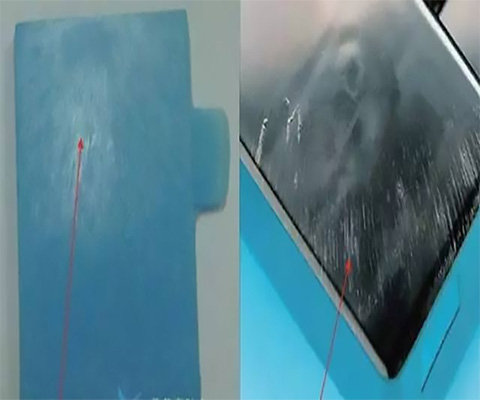The "floating fiber" phenomenon of glass fiber reinforced nylon will seriously affect the appearance of the product. This article will analyze the reasons for the exposure of glass fiber and provide effective solutions.
Adding fillers such as glass fiber and toughening agents to nylon can significantly increase the mechanical properties of the material. The results show that as the content increases, the tensile strength and flexural strength of the material are greatly improved, while the impact strength is more complicated. In general, adding 30% to 35% of glass fiber and 8% to 12% of toughening agents will give the material the best comprehensive mechanical properties.

(Figure 1)
But in the process of glass fiber reinforced nylon injection molding, the phenomenon of "floating fiber" (Figure 1) often occurs. Floating fiber is also called exposed fiber, that is, the glass fiber is exposed on the surface of the product, which is rough and unacceptable in appearance. Due to the exposure of glass fiber, the application of this kind of product is subject to certain restrictions. Currently, they are mainly used in some high-strength structural parts. And all the appearance parts made of fiber-reinforced materials are basically matte or etched surfaces (such as power tools), because ordinary fiber-reinforced materials are difficult to achieve a bright appearance.
1. Reasons for the "floating fiber" phenomenon of glass fiber reinforced nylon
There are many reasons for the formation of floating fibers, the most important ones are the following three:
(1) The compatibility of glass fiber and nylon is poor. Because the plastic melt is affected by the friction and shear force of the screw, nozzle, runner, and gate during the flow process, it will cause a difference in local viscosity and damage the surface of the glass fiber. The lower the melt viscosity of the interface layer, the more severe the interface layer is damaged, and the smaller the bonding force between the glass fiber and the resin. When the bonding force is small to a certain level, the glass fiber will get rid of the bondage of the resin matrix. Gradually accumulate to the surface and expose.
(2) The specific gravity difference between glass fiber and base material. During the plastic melt flow process, due to the difference in the fluidity of glass fiber and resin, and the difference in mass density, the two have a tendency to separate, and the glass fiber floats to the surface. The resin sinks inward, so the glass fiber is exposed.
(3) Fountain effect When nylon melt is injected into the mold, it will form a "fountain" effect, that is, the glass fiber will flow from the inside to the outside and contact the surface of the cavity. Because the mold surface temperature is low, the glass is light and condenses quickly. The fiber is frozen instantaneously, and if it is not fully surrounded by the melt in time, it will be exposed and form a "floating fiber". Therefore, the formation of the "floating fiber" phenomenon is not only related to the composition and characteristics of plastic materials but also related to the molding process, which has greater complexity and uncertainty.
2. Spraying solutions for the "floating fiber" of glass fiber reinforced nylon
In actual production, there are various measures to improve the "floating fiber" phenomenon.
(1) Improve the compatibility of glass fiber and nylon
Adding compatibility, dispersant, and lubricant additives to the molding material, including silane coupling agent, maleic anhydride grafting compatibilizer, fatty acid lubricant, and some domestic or imported anti-glass fiber exposure agents, etc. These additives improve the compatibility between the glass fiber and the resin, improve the uniformity of the dispersed phase, increase the interface bonding strength, reduce the separation of the glass fiber and the resin, thereby improving the exposure of the glass fiber. For example, studies have shown that adding a compatibilizer to the matrix will significantly improve the compatibility of the modified glass fiber in the matrix compared with no added material.
(2) Improve molding process conditions
a. Increase filling speed
After increasing the speed, although the flow rate of glass fiber and plastic are different, compared with high-speed injection, the ratio of the relative speed difference is small.
b. Increase mold temperature
This effect is the biggest. Increasing the mold temperature is to reduce the contact resistance between the glass fiber and the mold, and to make the speed difference between the glass fiber and the plastic as small as possible. And make the middle melting layer when the plastic flows as thick as possible, and make the skin layers on both sides as thin as possible so that it seems that the smooth river bank cannot hold the branches. RHCM uses this principle to achieve a fiber-free appearance.
c. Reduce the temperature of the screw metering section and reduce the amount of sol
This is to minimize the possibility of plastic and glass fiber separation. Generally speaking, it has the least impact on the floating fiber, and it has little effect in actual operation. However, this can be a good solution to burnt. This is because after adding glass fiber, it is easy to block the exhaust channel, so it is difficult to exhaust at the end, and the glass fiber is easy to burn in a high-pressure and high-oxygen gas environment.
(3) Mould
The appearance surface of the product is deliberately made into a matte or etched surface to reduce the visual response of the exposed glass fiber.
Copyright © POLYROCKS CHEMICAL CO., LTD. All Rights Reserved |
Sitemap
| Powered by
 粤ICP备10040394号
粤ICP备10040394号
CONTACT US
QUICK ENQUIRE FORM
* Indicate Mandatory fields